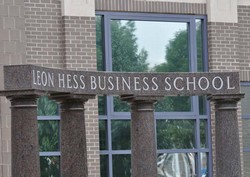There’s a makeover of sorts sweeping the fashion industry, but it’s not about what clothes look like. Instead, it’s about how retailers are talking about them.
ModCloth, the e-commerce site specializing in vintage-inspired fashions and accessories, recently announced that it’s removing the “plus” section of clothing from its home page, and is in the process of eliminating plus-sized language from its website.
Shoppers will be able to find sizes for a range of body types all in one place on the site, or there will be a way for them to search for pieces that come in sizes above XL via a filter to be called “extended sizes,” which someday could also include petite, tall and other size variations.
“ModCloth’s mission is to help women feel like the best version of themselves, and we believe this is another way we can promote inclusivity,” co-founder and chief creative officer Susan Koger said in a statement.
Koger, a Carnegie Mellon University graduate, started the company in 2002 with Eric Koger, who is now her husband. Employees are based in Pittsburgh, San Francisco and Los Angeles.
The online retailer conducted a survey about the experience and perceptions of plus-sized fashion. It involved about 1,500 women ages 18 to 35 in the U.S. who identify as wearing a size 16 or larger.
About 60 percent of them reported feeling embarrassed about going to a separate store or department to find their size, the survey found, while about 65 percent said they’d prefer to find their size in the same section as all the other sizes.
Koger and the site’s “ModStylists” witnessed these findings firsthand at its recent pop-up shops in Los Angeles and San Francisco. In these temporary brick-and-mortar stores, styles in many sizes were displayed side by side, rather than in their respective sections, and the response from shoppers was positive.
ModCloth also strives to carry styles that are available in many sizes. For instance, most pieces in its debut in-house label of dresses and separates, called You x ModCloth, come in sizes XS through 4X.
But ModCloth isn’t the only retailer trying to better cater to curvy fashionistas. Department store chain J.C. Penney is launching more options for sizes 14W to 24W and 1X to 3X in stores and online.
It also plans to replace the plus-sized apparel section on its website with something called “The Boutique,” which will be stocked with looks for fuller figures for daytime, social occasions and fitness.
Also making headlines has been Lane Bryant’s new #PlusIsEqual campaign, a series of black-and-white images by fashion photographer Cass Bird that features plus-sized models proudly showing off their curves.
It’s been splashed across TV ads, social media and major fashion magazines like Vogue. There’s even an app that allows any woman to superimpose herself onto a billboard image of the campaign that can be shared on social media. According to Lane Bryant, which specializes in women’s sizes 14 through 28, 67 percent of U.S. women wear a size 14 to 34, but those women often aren’t seen in fashion editorials, on television or elsewhere in the media.
“We believe all women should be seen and celebrated equally,” the retailer declares on the campaign’s website, plusisequal.com. “It’s time to represent.”
IMAGE TAKEN from blog.modcloth.com




